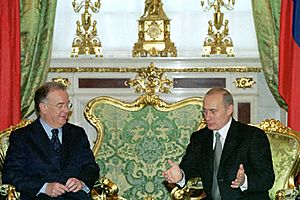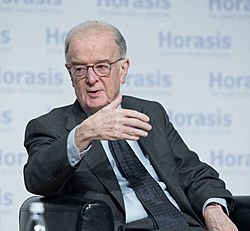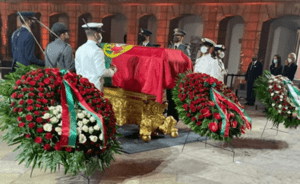Jorge Sampaio facts for kids
Quick facts for kids
Jorge Sampaio
GColTE GColIH GColL
|
|
|---|---|

Jorge Sampaio in 2003
|
|
| President of Portugal | |
| In office 9 March 1996 – 9 March 2006 |
|
| Prime Minister | António Guterres José Manuel Barroso Pedro Santana Lopes José Sócrates |
| Preceded by | Mário Soares |
| Succeeded by | Aníbal Cavaco Silva |
| High-Representative for the Alliance of Civilizations | |
| In office 1 April 2007 – 1 March 2013 |
|
| Preceded by | Position established |
| Succeeded by | Nassir Abdulaziz Al-Nasser |
| Mayor of Lisbon | |
| In office 22 January 1990 – 15 November 1995 |
|
| Preceded by | Nuno Krus Abecasis |
| Succeeded by | João Soares |
| Secretary-General of the Socialist Party | |
| In office 15 January 1989 – 23 February 1992 |
|
| President | João Ferraz de Abreu |
| Preceded by | Vítor Constâncio |
| Succeeded by | António Guterres |
| Leader of the Opposition | |
| In office 6 November 1988 – 23 February 1992 |
|
| Prime Minister | Aníbal Cavaco Silva |
| Preceded by | Vítor Constâncio |
| Succeeded by | António Guterres |
| Personal details | |
| Born |
Jorge Fernando Branco de Sampaio
18 September 1939 Lisbon, Portugal |
| Died | 10 September 2021 (aged 81) Lisbon, Portugal |
| Political party | Socialist Party |
| Spouses | Karin Schmidt Dias (div.) Maria José Rodrigues Ritta |
| Children | Vera Ritta de Sampaio André Ritta de Sampaio |
| Alma mater | University of Lisbon |
| Profession | Lawyer |
| Signature | |
Jorge Fernando Branco de Sampaio (born September 18, 1939 – died September 10, 2021) was an important Portuguese lawyer and politician. He served as the President of Portugal for two terms, from 1996 to 2006.
Before becoming president, he was the mayor of Lisbon from 1990 to 1995. He also led the Socialist Party from 1989 to 1992. Later, he became a special representative for the Alliance of Civilizations from 2007 to 2013.
Jorge Sampaio was known for opposing the Estado Novo dictatorship. This was a time when Portugal was not a democracy. He helped students protest in the 1960s and worked as a lawyer for people who were put in prison for political reasons. As president, he played a big part in helping East Timor become independent. He also oversaw the return of Macau to China.
Contents
Early Life and Education
Jorge Sampaio was born in Lisbon, Portugal, on September 18, 1939. His family lived in the United States and the United Kingdom for a few years. This was because his father, Arnaldo de Sampaio, was a doctor.
As a child, Jorge attended the Queen Elizabeth School. He also lived in Baltimore, USA, where his father taught at Johns Hopkins University. There, he learned boxing and swimming. He also took piano lessons.
When he returned to Portugal, he went to Pedro Nunes High School. Later, he studied law at the University of Lisbon.
Starting a Political Career
Jorge Sampaio began his political journey as a university student. He was very active in student protests against the Estado Novo regime. This government was not democratic. He led the Lisbon students union from 1960 to 1961.
After finishing his law degree in 1961, Sampaio became a lawyer. He often defended political prisoners. He helped people who were arrested for speaking out against the government. He also worked for the Portuguese Bar Association.
The Carnation Revolution
On April 25, 1974, the Carnation Revolution happened in Portugal. This event ended the dictatorship peacefully. Jorge Sampaio was part of this historic moment. He even came up with a famous slogan: "25 de Abril, sempre!" which means "Always 25 April!"
After the revolution, Sampaio helped start a political group called the Movement of Socialist Left. However, he soon left it because he disagreed with its ideas. In 1978, he joined the Socialist Party.
He was first elected to the Assembly of the Republic in 1979. This is like Portugal's parliament. He served there until 1991. From 1979 to 1984, he was the first Portuguese member of the European Commission for Human Rights. This group works to protect human rights in Europe.
In 1989, Jorge Sampaio became the leader of the Socialist Party. He led the party until 1992.
Mayor of Lisbon
In 1989, Jorge Sampaio was elected the Mayor of Lisbon. He worked with other left-wing parties to win the election. This was a new kind of alliance in Portuguese politics.
As mayor, he helped rebuild the Chiado district. This area had been damaged by a fire in 1988. He also helped prepare Lisbon to be the European Capital of Culture in 1994. This brought many cultural events to the city.
Sampaio was re-elected mayor in 1993. In 1995, he decided to run for president. So, he resigned as mayor.
Becoming President of Portugal
On July 13, 1995, Jorge Sampaio announced he would run for president. He was supported by the Socialist Party. He won the election on January 14, 1996. He became the 18th President of Portugal on March 9, 1996. For the first time, the president and the government were from the same political party.
Soon after becoming president, he had heart surgery. He recovered well. In May 1998, he opened the Expo '98 in Lisbon. This was a big world's fair.
Helping East Timor
When Sampaio became president, he worked to help East Timor gain independence. East Timor was a territory that had been taken over by Indonesia. In 1999, there was a vote for independence in East Timor. After the vote, there was a lot of violence.
President Sampaio and the Portuguese government worked hard to get international help. They pushed for a peacekeeping force to enter East Timor. On September 15, 1999, the United Nations sent a force to help.
José Ramos-Horta, a Nobel Peace Prize winner from East Timor, said Sampaio was a "great defender" of their cause. Jorge Sampaio visited East Timor in February 2000. He was the first Portuguese head of state to do so. He visited again in 2002, after East Timor became an independent country.
Macau's Return to China
In 1999, negotiations finished for the return of Macau to China. Macau had been a Portuguese territory for over 400 years. On December 19, 1999, President Sampaio attended the ceremony. He gave a farewell speech that marked the end of Portuguese rule in Macau.
Second Term as President
Jorge Sampaio ran for re-election in 2001. He won again, starting his second term.

In 2001, the prime minister resigned. Sampaio decided to call new elections for March 2002. This was to solve a political crisis. The new prime minister was José Manuel Barroso.
In 2003, Sampaio invited leaders from other European countries to Portugal. They discussed the future of the European Union.
In 2004, the prime minister resigned again. Sampaio appointed a new prime minister, Pedro Santana Lopes. However, Sampaio later felt the new government was not stable. So, he dissolved the parliament and called new elections for February 2005. José Sócrates became the new prime minister after these elections.
Jorge Sampaio's presidency ended on March 9, 2006. Aníbal Cavaco Silva, the person he had defeated in 1996, became the next president.
Life After the Presidency
After being president, Jorge Sampaio continued to be active. He became a member of the Portuguese Council of State. This group advises the president. He also joined the Club de Madrid, which is a group of former democratic leaders.
In 2006, the United Nations Secretary-General asked Sampaio to be a special envoy. His job was to help stop tuberculosis around the world. In 2007, he became the High Representative for the Alliance of Civilizations. He held this role until 2013.
From 2013, he led a project called the Global Platform for Syrian Students. This project helped young people from Syria get an education. This was especially important because of the civil war and refugee crisis. In 2021, he announced that this platform would also help Afghan female students.
Personal Life and Legacy
Jorge Sampaio was married twice. He had two children with his second wife, Maria José Ritta.
He enjoyed playing the piano and was a fan of the Sporting CP sports club. He was known for being shy but also very kind. He had a distinctive British accent and red hair.
Jorge Sampaio passed away on September 10, 2021, at the age of 81. Portugal declared three days of national mourning. His funeral was a State funeral, attended by many important national and international leaders. He was buried in Lisbon.
Awards and Recognition
Jorge Sampaio received many awards during his life. These awards recognized his work for democracy and human rights.
In 2004, he received the Charles V European Award. In 2009, he was given the North–South Prize by the Council of Europe. In 2015, he received the Nelson Rolihlahla Mandela Prize. This award recognized his fight for democracy in Portugal. It also honored his work helping political prisoners and raising awareness about tuberculosis.
Portuguese Awards
- Grand Oficial of the Order of Prince Henry (1983)
- Sash of the Three Orders (1996-2006)
- Grand Collar of the Order of the Tower and Sword (2006)
- Grand Collar of the Order of Liberty (2006)
- Grand Collar of the Order of Prince Henry (2018)
International Awards
- Grand Cross of the Order of Merit (Cyprus, 1990)
- Grand Cross of the Order of the Lion of Finland (Finland, 1991)
- Grand Cross of the Order of the Southern Cross (Brazil, 1991)
- Grand Cross of the Order of Orange-Nassau (Netherlands, 1992)
- Grand Cross of the Order of Bernardo O'Higgins (Chile, 1993)
- Grand Cross of the Order of the Republic (Tunisia, 1994)
- Knight-Grand Cross of the Royal Victorian Order (United Kingdom, 1994)
- Grand Cross of the Order of Ouissam Alaouite (Morocco, 1995)
- Grand Cross with Star of the Order of Merit of the Federal Republic of Germany (Germany, 1996)
- Medal of the National Order of the Boé Hills (Guinea-Bissau, 1996)
- Grand Cross of the Order of Rio Branco (Brazil, 1996)
- First Grade of the Order of Friendship and Peace (Mozambique, 1997)
- Collar of the Order of Isabella the Catholic (Spain, 1996)
- Grand Cross of the Order of the White Eagle (Poland, 1997)
- Grand Collar of the Order of the Southern Cross (Brazil, 1997)
- Grand Collar and Sash of the Order of Prince Yaroslav the Wise (Ukraine, 1998)
- Collar of the Order of the Liberator (Venezuela, 1999)
- Grand Cross of the Order of Merit (Hungary, 1999)
- Collar of the Order of the Aztec Eagle (Mexico, 1999)
- Grand Cross Special Class of the Order of Merit of the Federal Republic of Germany (Germany, 1999)
- Grand Cross of the Legion of Honour (France, 1999)
- Grand Cross of the Order of the Redeemer (Greece, 1999)
- Grand Collar of the Order of the Star of Romania (Romania, 2000)
- Golden Medal of the Order of Freedom of the Republic of Slovenia (Slovenia, 2000)
- Grand Collar of the Order of 7 September (Tunisia, 2000)
- Collar of the Order of Charles III (Spain, 2000)
- Grand Cross of the Order of Leopold (Belgium, 2000)
- Grand Collar of the Order of Amilcar Cabral (Cape Verde, 2001)
- Grand Collar of the Order of Merito (Chile, 2001)
- Knight Grand Cross with Grand Cordon of the Order of Merit of the Italian Republic (Italy, 2001)
- Grand Cross of the Order of the Equatorial Star (Gabon, 2002)
- Grand Cross of the Order of Francisco de Miranda (Venezuela, 2002)
- Grand Collar of the Order of Merit (Hungary, 2002)
- Knight Grand Cross of the Order of St Michael and St George (United Kingdom, 2002))
- Grand Collar of the Order of the Liberator General San Martín (Argentina, 2002)
- Grand Collar of the Order of the White Rose of Finland (Finland, 2003)
- Grand Collar of the Order of the Cross of Terra Mariana (Estonia, 2003)
- Grand Cross of the Order of Vytautas the Great (Lithuania, 2003)
- First Class White Double Cross of the Order of the White Double Cross (Slovakia, 2003)
- Knight Grand Cross of the Order of St. Olav (Norway, 2004)
- Grand Collar of the Order of the Athir (Algeria, 2004)
- Grand Cordon of the Order of Leopold (Belgium, 2005)
- Collar of the National Order of Merit (Paraguay, 2006)
- First Class of the Order of the White Star (Estonia, 2006)
- Grand Collar of the Order of Timor-Leste (Timor-Leste, 2009)
- Knight of the Order of the Gold Lion of the House of Nassau (Luxembourg, 2010)
Honorary Degrees
- Honoris causa from the University of Aveiro (2008)
- Honoris causa from the University of Coimbra (2010)
- Honoris causa from the University of Lisbon (2010)
- Honoris causa from King's College London (2014)
- Honoris causa from the University of Porto (2015)
See also
 In Spanish: Jorge Sampaio para niños
In Spanish: Jorge Sampaio para niños




